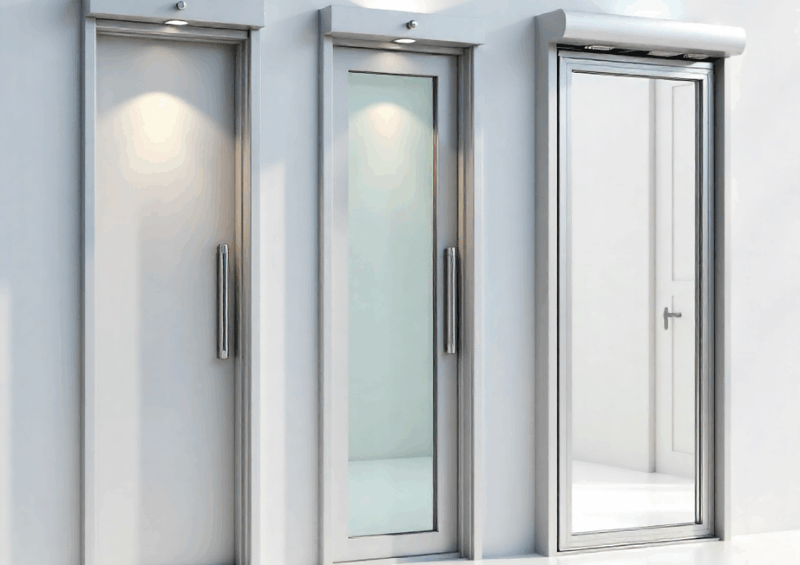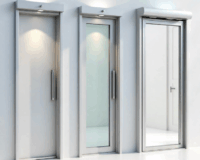Automatic doors have become a standard requirement in modern architecture. Whether in shopping malls, office buildings, hospitals, airports, schools, factories, or luxury homes, the way doors open and close has a direct impact on convenience, security, accessibility, and energy efficiency. As building standards continue to evolve, architects, facility managers, and engineers now pay close attention to selecting the right automatic door opener types for each application.
This detailed guide explores the three most common types of automatic door openers—surface-mounted, concealed, and floor-mounted systems. We will explain how they work, where they are used, their advantages, and the key factors to consider before choosing one. If you’re planning a new project, renovation, or upgrade, this comprehensive breakdown will help you make a confident and informed decision.
Introduction: Why Understanding Automatic Door Opener Types Matters
Automatic door systems are more than just convenient—they are strategic components of a building’s operation. They improve traffic flow, enhance accessibility for people with disabilities, support hygiene in sensitive environments, and strengthen security. Choosing the wrong system can lead to excessive maintenance, noise issues, limited door compatibility, or safety concerns. Choosing the right one, however, creates long-lasting operational efficiency.
The three primary automatic door opener types—surface, concealed, and floor—each offer unique benefits. Understanding their differences not only saves costs but also ensures stability and long-term performance. This article will explain these differences in depth and help you evaluate which type is suitable for your needs.
What Are Automatic Door Opener Types?
In simple terms, automatic door opener types refer to the mechanism and installation style used to automate door movement. The opener includes components such as a motor, control unit, sensors, arm systems, and safety equipment.
The types differ based on:
-
Motor placement
-
Mounting design
-
Visibility of components
-
Suitable door weight
-
Aesthetic requirements
-
Space available above, within, or below the door
The three main categories covered in this guide are:
-
Surface-Mounted Automatic Door Openers
-
Concealed (In-Header) Automatic Door Openers
-
Floor-Mounted Automatic Door Openers
Let’s explore each of these in detail.
Surface-Mounted Automatic Door Openers
What Is a Surface-Mounted Opener?
A surface-mounted automatic door opener is installed directly onto the surface of the door frame or header, meaning all its components are visible from outside. This is the most common and widely used type due to its versatility, affordability, and ease of maintenance. Most retrofit projects rely on this type because it doesn’t require structural modification.

How It Works
The motor, control board, gearbox, and opening arm are all housed inside a surface-mounted casing. When triggered by sensors or push plates, the motor activates and pulls or pushes the door open. Different arm systems, such as push arms or slide arms, allow flexible installation depending on the door swing direction.
Best Applications
Surface-mounted openers are ideal for:
-
Office buildings and corporate facilities
-
Hospitals and clinics
-
Schools and universities
-
Retail shops and shopping malls
-
Restaurants and cafes
-
Hotels and hospitality
-
Residential accessibility upgrades
-
Public buildings and government offices
Because they can handle lightweight to heavy doors, they fit almost any environment.
Advantages of Surface-Mounted Systems
-
Easy and fast installation
-
Cost-effective compared to concealed and floor openers
-
Suitable for retrofits and new builds
-
Easy to access and repair
-
Compatible with most door materials
-
High reliability and long lifespan
Limitations
While extremely practical, surface-mounted openers may have:
-
Less aesthetic appeal, since they are visible
-
More exposure to environmental elements, affecting lifespan outdoors
-
Noise issues if using older or low-quality models
Even so, they remain the preferred choice for functionality-oriented projects.
Concealed Automatic Door Openers
What Is a Concealed Opener?
A concealed automatic door opener, sometimes called an in-header opener or hidden door opener, is installed inside the top frame (header) of the door. The mechanism is hidden from view, offering a streamlined, modern appearance. These openers are ideal when aesthetics are a priority.

How It Works
The motor and mechanism are placed inside a custom or pre-engineered header unit. Only the slim linkage connecting the door is visible. The concealed design requires precise engineering and enough space inside the frame to house the opener.
Best Applications
These openers are commonly used in:
-
Luxury homes
-
Hotels and high-end hospitality spaces
-
Architectural and premium office buildings
-
Airports and premium retail stores
-
Museums, galleries, and public spaces requiring hidden infrastructure
They are especially attractive for glass doors and environments where the door system must blend seamlessly with the interior.
Advantages of Concealed Systems
-
Premium aesthetic with no visible motor
-
Quiet operation, ideal for noise-sensitive spaces
-
Protection from external weather and dust
-
Enhances the architectural design
-
Suitable for sleek modern interiors
Limitations
However, concealed openers have challenges:
-
Cost is higher than surface-mounted options
-
Installation complexity—requires structural modification
-
Maintenance access is harder, increasing repair time
-
Not suitable for very heavy fire-rated doors unless using high-end systems
Despite this, concealed openers remain the top choice for design-driven projects.
Floor-Mounted Automatic Door Openers
What Is a Floor-Mounted Opener?
A floor-mounted automatic door opener is integrated into the floor beneath the door pivot. It operates similarly to a floor spring but is motorized. This type is often used for heavy doors or in situations where wall or header installations are impossible or undesired.

How It Works
The mechanism is housed inside a floor box. A pivot connection transfers motion to the door, allowing controlled opening and closing. Sensors or push plates send signals to the motor, which drives the door in a smooth arc.
Best Applications
Floor-mounted openers are ideal for:
-
Heavy or oversized doors
-
Frameless glass doors
-
Revolving-style swing doors
-
Architectural entrances with minimal structural space
-
Commercial buildings with high traffic
-
Museums and exhibition centers
-
Premium retail stores and showrooms
They are commonly used where minimal visibility and smooth operation are essential.
Advantages of Floor-Mounted Systems
-
Virtually invisible, ideal for luxury aesthetics
-
Perfect for large or heavy doors
-
Extremely stable and durable due to floor anchoring
-
Smooth and quiet movement
-
Ideal for frameless glass entrances
Limitations
Floor-mounted openers also come with some drawbacks:
-
Higher installation cost
-
Requires floor trenching, which is not ideal for retrofits
-
Potential water or dust ingress if not sealed properly
-
Maintenance may require lifting floor plates
Nevertheless, they remain unmatched for heavy-duty architectural doors.
Key Factors to Consider When Choosing Automatic Door Opener Types
Selecting between surface, concealed, and floor-mounted systems depends on several important criteria.
Aesthetic Requirements
-
If aesthetics are a priority → Concealed or floor-mounted
-
If functionality matters most → Surface-mounted
Door Weight and Size
-
Heavy or oversized doors → Floor-mounted
-
Standard commercial doors → Surface-mounted
-
Glass or premium doors → Concealed or floor-mounted
Installation Conditions
-
Limited budget and quick installation → Surface-mounted
-
New construction with header space → Concealed
-
No header space → Floor-mounted
Maintenance Considerations
-
Easy access and fast repair → Surface-mounted
-
Long-term stability → Floor-mounted
Cost and Budget Planning
-
Low cost → Surface-mounted
-
Medium cost → Concealed
-
Higher investment → Floor-mounted
Application Environment
Healthcare, retail, hospitality, and industrial environments each have different needs. For instance:
-
Hospitals prefer quiet concealed systems
-
Factories favor durable surface-mounted units
-
Luxury hotels opt for floor-mounted or concealed systems
When planning your automatic door opener types, make sure your designs comply with Australia’s Disability (Access to Premises) Standards, as outlined in the government’s Premises Standards for accessible buildings.
Safety Features Across All Automatic Door Opener Types
Regardless of type, a high-quality automatic door system must include:
-
Obstacle detection sensors
-
Slow-start and slow-stop motion
-
Emergency break-away function
-
Battery backup options
-
Push-to-open accessibility compliance
-
Manual override in case of power failure
Safety compliance ensures the system is reliable and suitable for public environments.
Looking for reliable, high-quality automatic door openers? Check out Digital Home Systems’ range in their smart door automation solutions and make your purchase today.
The Future of Automatic Door Opener Types
Modern automatic door innovations continue evolving. Future-ready systems now incorporate:
-
Smart building integration
-
Touchless activation for hygiene
-
AI-driven motion detection
-
Energy-saving technology
-
Wireless connectivity and remote control
-
Enhanced fire and security sensors
As buildings move toward automation and sustainability, choosing the right opener type becomes even more important.
Curious about the next-generation of automatic door systems? Dive into Digital Home Systems’ insights on the future of smart door automation
Conclusion
Selecting the right automatic door opener type is a critical decision that impacts both the functionality and aesthetics of your building. Whether you are designing a commercial facility, residential property, industrial warehouse, or luxury hotel, understanding the differences between surface-mounted, concealed, and floor-mounted automatic door openers ensures you get the best combination of performance, durability, and design.
Surface-mounted automatic door openers offer affordability, quick installation, and versatility, making them ideal for retrofits, office buildings, hospitals, and high-traffic areas. They are easy to maintain, compatible with most door types, and perfect for projects where efficiency and reliability are the priority.
Concealed automatic door openers provide a premium, seamless appearance that blends with modern architectural designs. They are quiet, secure, and suitable for spaces where aesthetics matter, such as luxury homes, high-end retail, and corporate offices. While installation and maintenance may be more complex, the elegance and unobtrusive design make concealed systems a top choice for design-focused projects.
Floor-mounted automatic door openers excel in supporting heavy or oversized doors and offer precise, smooth operation. These systems are nearly invisible, highly durable, and perfect for frameless glass doors, pivot doors, and high-end commercial entrances. Floor-mounted systems are ideal for environments where minimal visual impact and maximum engineering performance are required.
Ultimately, the right automatic door opener type depends on factors such as door weight, traffic volume, budget, aesthetics, and installation requirements. By carefully evaluating your building’s needs and matching them with the appropriate opener type, you can improve accessibility, enhance user experience, and ensure long-term operational efficiency. Additionally, integrating modern safety features, smart sensors, and touchless controls can further optimize your automatic door systems, providing a seamless, secure, and convenient entry solution for all users.
Investing in the correct automatic door opener type not only supports functionality and compliance but also elevates the overall appearance and professionalism of your building. Whether you prioritize cost-efficiency, aesthetic appeal, or heavy-duty performance, understanding the strengths and limitations of each system ensures you make an informed decision that delivers value and reliability for years to come.






